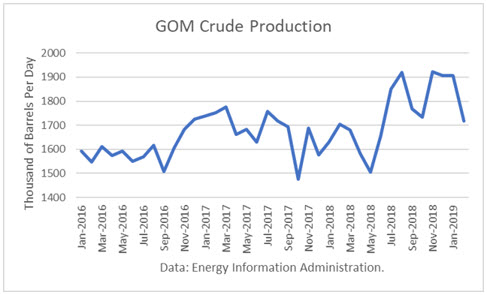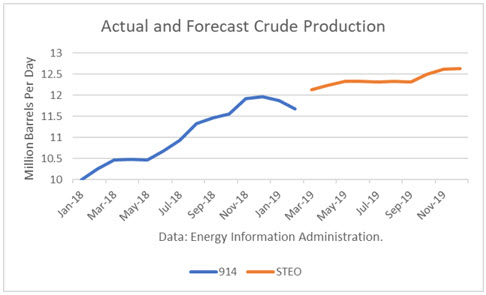The Energy Information Administration reported that February crude oil production averaged a surprising 11.683 million barrels per day (mmbd), down 187,000 b/d from January. The drop was totally the result of unscheduled maintenance in the Gulf of Mexico (GOM), which averaged 1.719 mmbd. Production had been over 1.9 mmbd in November through January.

Despite drops in January and February, crude production still rose by a spectacular 1.219 mmbd from June through February, a period when capacity takeaway constraints had been expected to slow down the growth in Texas.
Production in Texas rose by 69,000 b/d to a record 4.890 mmbd. That was nearly offset by a decline in North Dakota of 64,000 b/d due to seasonal factors.

The year-over-year gains have been especially impressive with the February figure being 1.435 mmbd. And this number only includes crude oil. Other supplies (liquids) that are part of the petroleum supply add to that. For February, that additional gain is about 690,000 b/d.

The EIA-914 Petroleum Supply Monthly (PSM) figure was 335,000 b/d lower than the weekly data reported by EIA in the Weekly Petroleum Supply Report (WPSR), averaged over the month, of 12.018 mmbd.

The February figure was 190,000 b/d lower than the 11.880 mmbd estimate for that month in the March Short-Term Outlook. That implies no need for another upward “rebenchmarking” to EIA’s model in future production levels at this time since the difference was GOM unscheduled maintenance.
The EIA is projecting that 2019 production will average 12.290 mmbd. As shown below, the growth rate is very slow through 2019.

According to another report, the Permian Basin is expected to add as much as 2.0 mmbd in 2019 as three new pipelines come online. And in 2020, more new pipelines are expected.
Conclusions
The recent lull in crude production was largely due to seasonal factors. However, some of the slowdown likely reflects the drop in oil prices during 4Q18. However, with the rebound in prices during 2019, production incentives for the balance of 2019 remain strong.
Check back to see my next post!
Best,
Robert Boslego
INO.com Contributor - Energies
Disclosure: This contributor does not own any stocks mentioned in this article. This article is the opinion of the contributor themselves. The above is a matter of opinion provided for general information purposes only and is not intended as investment advice. This contributor is not receiving compensation (other than from INO.com) for their opinion.
